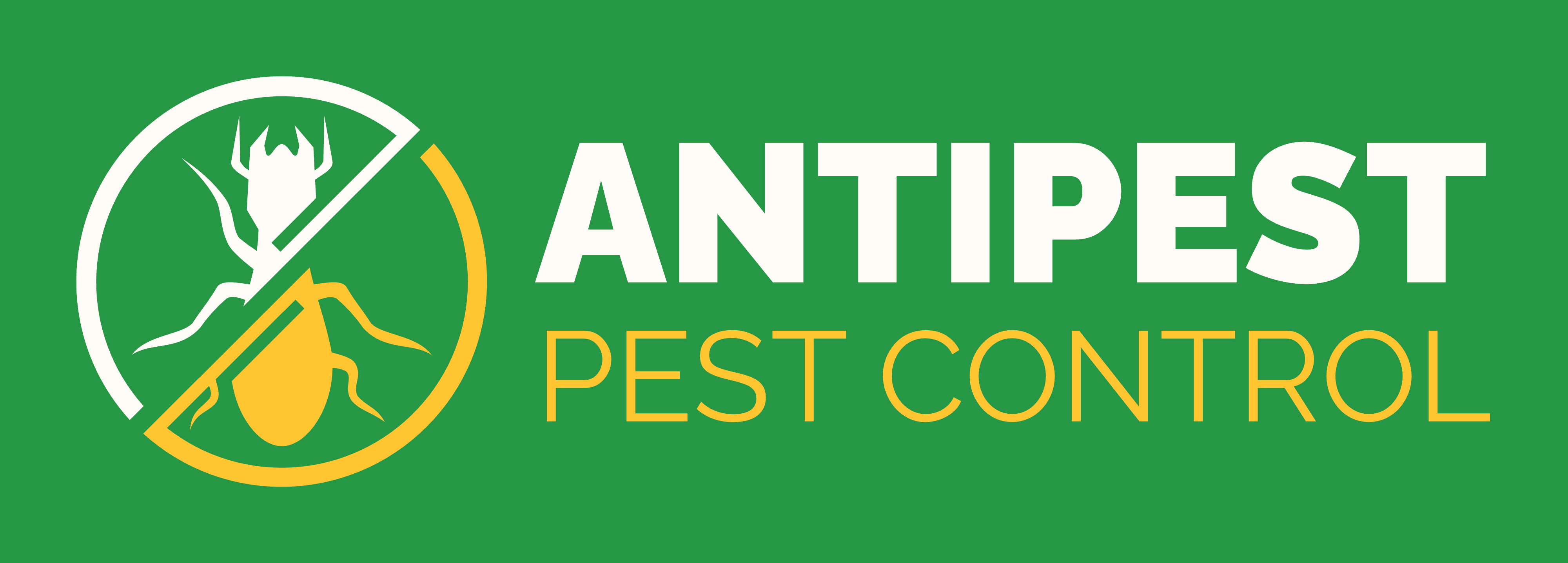Waking up covered in itchy red dots is nobody’s idea of a good morning. Yet most of us stumble into that very scenario at least once, immediately typing “bed bug bites vs flea bites” into our phones while scratching furiously. This post walks you through the tell-tale signs, quick fixes, and long-term strategies so you can reclaim your sleep (and sanity) from whichever tiny pest decided you were breakfast.
Table of Contents
The Morning Mystery : Why Those Bites Matter?
You don’t have to be an entomologist to solve the “bed bug bites vs flea bites” puzzle, but knowing the difference saves cash and stops the itch faster. Bed bugs sneak out at night, hide in mattresses, and make you think twice about hotel sheets. Fleas, on the other hand, hitchhike on pets, leap like Olympic athletes, and leave everyone, human and furry, miserable. Misidentifying the culprit wastes money on the wrong treatments and lets the real invasion simmer.
What are Bed Bugs and Understanding Bed Bugs Bites?
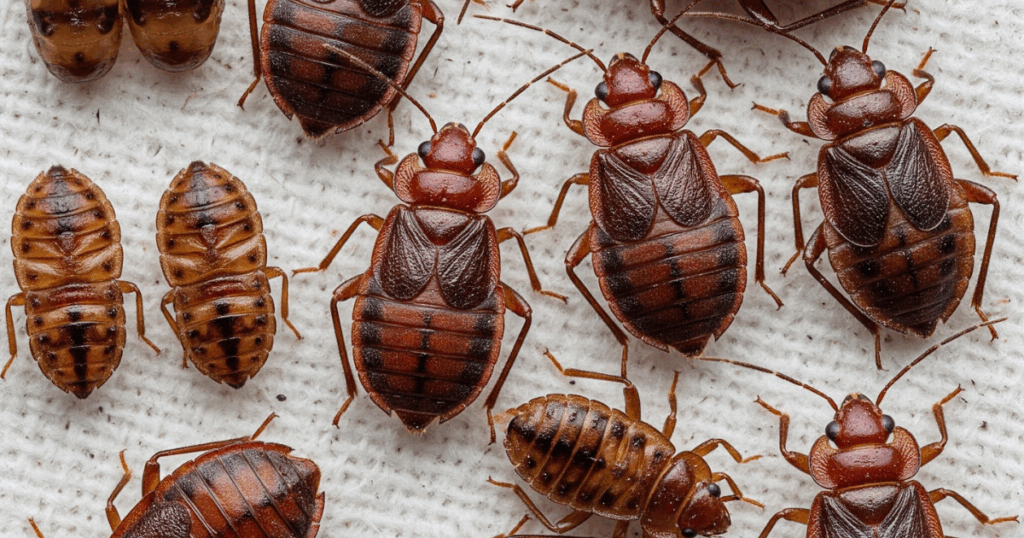
Bed bugs are nocturnal parasites that feed exclusively on blood, typically targeting humans while they sleep. When examining bed bug bites vs flea bites, understanding bed bug behavior is essential for accurate identification. These tiny insects inject a mild anesthetic during feeding, so you won’t feel the bite immediately. Bite marks usually appear hours or even days later, making bed bug bites vs flea bites detection challenging.
- Bed bug bites manifest as small, red welts that become inflamed and itchy. Unlike other insect bites, they appear in distinctive linear patterns across exposed skin areas. This pattern recognition helps distinguish bed bug bites vs flea bites, as each pest creates unique bite characteristics.
- These pests hide in mattress seams, bed frames, and nearby furniture during daylight hours, feeding methodically every few days. Understanding this behavior is crucial when comparing bed bug bites vs flea bites, since fleas have completely different feeding habits and create distinct bite locations on the human body.
Bed Bug Bites : Night-Shift Nuisance
Bed bugs are masters of stealth, crawling out between 1 AM and 5 AM. Their bites often:
- Show up late, welts appear 12–48 hours after feeding.
- Form neat lines, think tracks or zig-zag rows along exposed skin.
- Feel mildly itchy at first, then ramp up during the day.
- Target upper body, neck, arms, shoulders, and face are prime real estate.
| Bed Bug Bite Clues | What You’ll Notice |
| Delayed welts | Spots appear a day or two later |
| Linear pattern | 3–5 bites marching in a row |
| Rust-colored specks | Dots of dried blood on sheets |
| Sweet, musty odor | Stronger in heavy infestations |
A quick flashlight sweep along mattress seams often reveals shed skins, pepper-like droppings, or even a live bug waving hello. Catching just one confirms the worst: a bed bug party you never RSVP’d for.
Appearance and Symptoms of Bed Bug Bites
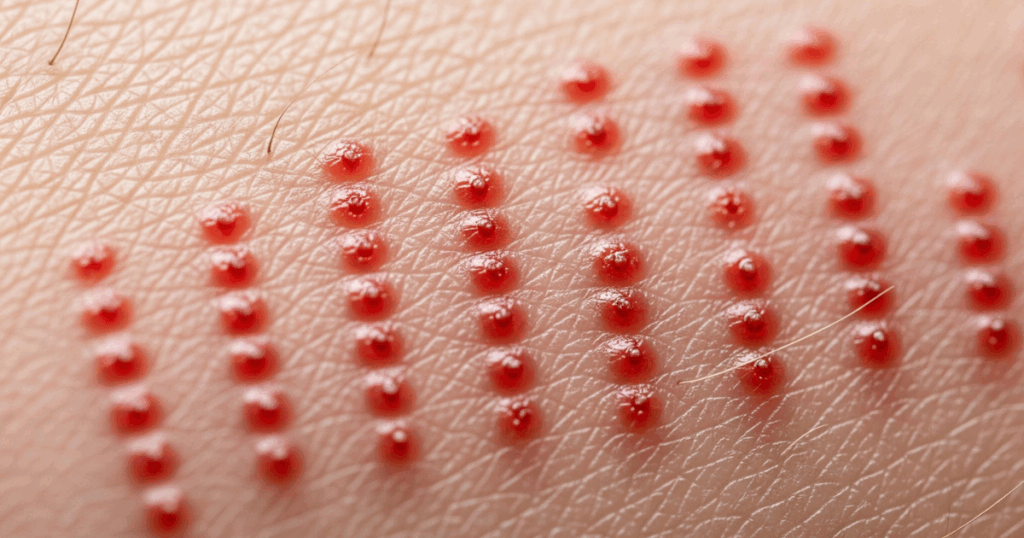
- Bed bug bites present several distinctive characteristics that help differentiate them from other insect bites. The welts typically appear as small, flat or slightly raised areas that may become red, inflamed, or blistered over time. Many people experience a slight burning sensation before the welts become visible.
- The bites commonly develop 24 to 48 hours after the initial feeding, appearing as red, itchy welts on exposed skin areas. In severe cases, the bites can swell significantly or develop into blister-like inflammations. The itching associated with bed bug bites tends to be less intense compared to flea bites, though individual reactions vary considerably.
| Characteristic | Description |
| Appearance | Small, red welts that are flat or slightly raised |
| Timing | Develop 24-48 hours after bite |
| Sensation | Slight burning before welts appear |
| Pattern | Linear or zigzag arrangements |
| Location | Exposed skin during sleep (arms, neck, face) |
Bite Patterns and Locations for Bed Bug Bites
One of the most reliable ways to identify bed bug bites is through their characteristic patterns. These bites often appear in clusters or follow linear arrangements, frequently described as zigzag patterns across the skin. The distinctive “breakfast, lunch, and dinner” pattern, while more commonly associated with flea bites, can occasionally occur with bed bugs as well.
- Bed bug bites typically target areas of exposed skin during sleep, including the arms, neck, shoulders, and face. Since these insects cannot jump or fly, they crawl across the skin to find suitable feeding spots, often creating the linear patterns that help identify their presence.
- The location of bites provides crucial information for identification. Unlike flea bites that concentrate on lower extremities, bed bug bites appear wherever skin is exposed during sleep, making the upper body a common target area.
What are Fleas and Understanding Flea Bites?
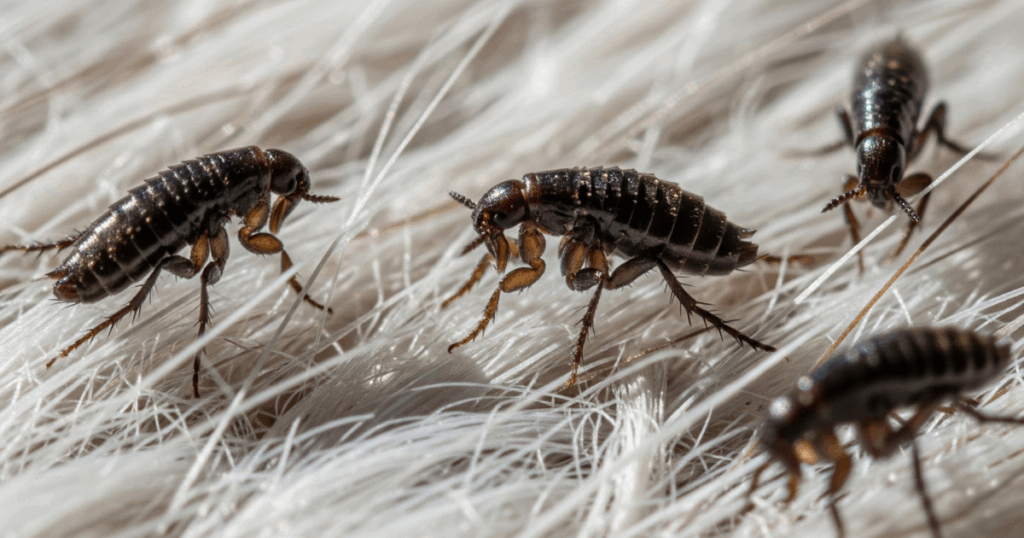
Fleas are highly mobile parasites capable of jumping significant distances to reach their hosts. These insects commonly live on pets like cats and dogs but readily bite humans when the opportunity arises. Unlike bed bugs, fleas can feed multiple times throughout the day and don’t require the same methodical approach to feeding, making bed bug bites vs flea bites identification crucial for proper treatment.
- Flea bites are characterized by their immediate onset and intense itching sensation. The bites typically develop within 30 minutes of contact, creating small red bumps with dark centers where the flea punctured the skin. This rapid development helps distinguish bed bug bites vs flea bites, as it contrasts sharply with the delayed reaction associated with bed bug wounds.
- These parasites inject saliva containing anticoagulants to keep blood flowing during feeding, which contributes to the immediate itching and inflammation. The intense itching associated with flea bites often leads to excessive scratching, potentially causing secondary infections if not properly managed. Understanding this difference is essential when comparing bed bug bites vs flea bites for accurate identification and treatment.
Flea Bites : Daytime Jump Scares
Now picture the family dog thumping his leg against the floor. Fleas love pets but won’t skip a free human buffet. Classic flea-bite traits include:
- Instant reaction, itch erupts within 30 minutes.
- Cluster of three, nicknamed “breakfast, lunch, dinner.”
- Dark red center topped with a lighter halo.
- Lower-body focus, ankles, calves, and behind the knees.
| Flea Bite Clues | What You’ll Notice |
| Rapid itch | Starts almost immediately |
| Clustered triangles | 2–3 bites in one small area |
| Flea dirt | Black specks on pet fur turn red when wet |
| Jumping specks | Fleas leap when you part carpet fibers |
Comb your pet over a white towel; those black pepper flakes that streak reddish brown when sprinkled with water are flea droppings, clear evidence your itchy ankles aren’t a bed bug’s handiwork.
Appearance and Symptoms of Flea Bites
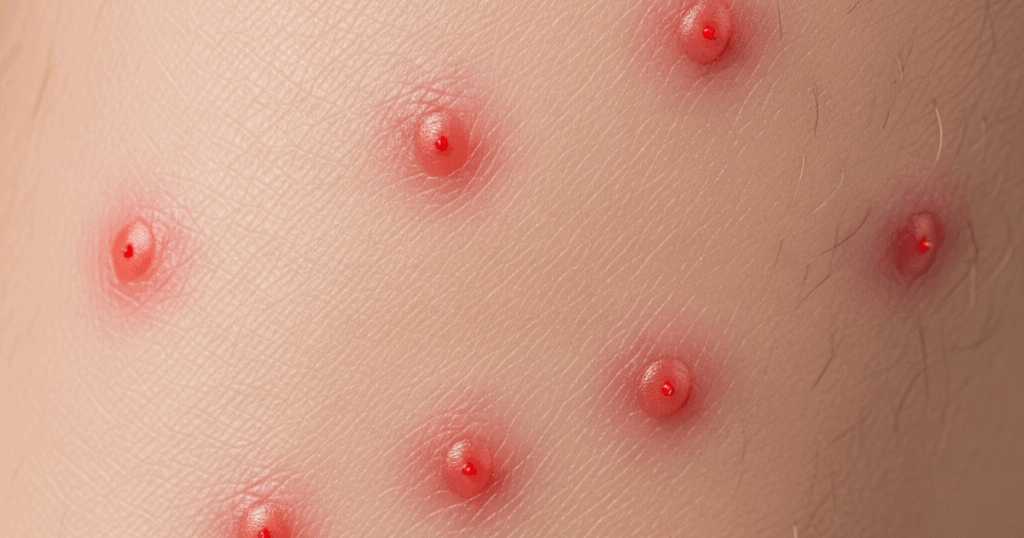
Flea bites create distinctive small, red bumps that often feature a dark red center surrounded by a lighter halo. These bites typically remain smaller than bed bug welts and develop almost immediately after contact.
- The intense itching begins shortly after the bite occurs, making flea bites immediately noticeable to most people.
- The bumps may develop into small blisters or open wounds if scratched excessively.
- On lighter skin tones, flea bites appear distinctly red and swollen, while on darker skin tones, they may blend more with the surrounding skin color but remain identifiable through their linear pattern and intense itching.
| Characteristic | Description |
| Appearance | Small red bumps with dark centers |
| Timing | Develop within 30 minutes |
| Sensation | Immediate intense itching |
| Pattern | Clusters of three (“breakfast, lunch, dinner”) |
| Location | Lower legs, ankles, and feet |
Bite Patterns and Locations for Flea Bites
Flea bites exhibit a distinctive clustering pattern, often appearing in groups of three small red bumps colloquially known as “breakfast, lunch, and dinner”. This pattern occurs because fleas may be interrupted during feeding by host movement or clothing friction, causing them to detach and reattach at nearby locations.
- The most common locations for flea bites include the lower legs, ankles, and feet, as fleas typically jump from carpeted areas or pet bedding onto human hosts. However, bites can occur anywhere on the body, particularly in areas where clothing fits tightly against the skin or in natural skin folds.
- Unlike the linear patterns associated with bed bug bites, flea bite arrangements tend to be more random and scattered, though they still maintain the characteristic clustering behavior that helps identify their source.
Key Differences Between Bed Bug Bites vs Flea Bites
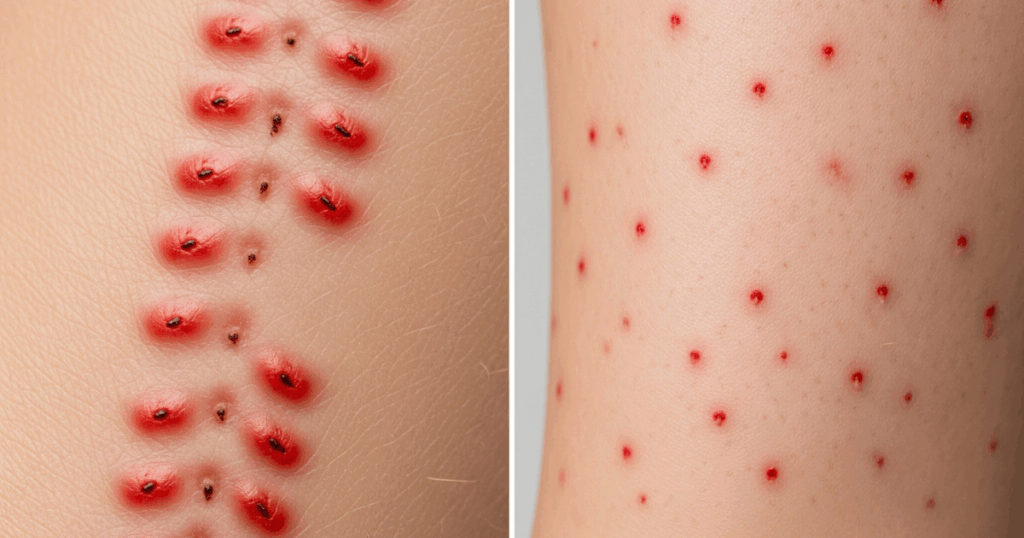
When comparing bed bug bites vs flea bites, several critical differences emerge that can help identify the source of your discomfort. The timing of bite appearance serves as one of the most reliable distinguishing factors.
- While flea bites develop within 30 minutes of contact, bed bug bites may not appear for several hours or even days.
- Location patterns provide another crucial difference when examining bed bug bites vs flea bites.
- Bed bug bites typically target exposed skin areas during sleep, appearing on the upper body, arms, neck, and face.
- Conversely, flea bites concentrate on the lower extremities, particularly around the ankles and feet where fleas can easily access human hosts.
- The intensity of itching also differs significantly between these two types of bites.
- Flea bites produce immediate, intense itching that can be quite overwhelming, while bed bug bites may cause less severe itching that develops gradually over time.
| Factor | Bed Bug Bites | Flea Bites |
| Development Time | 24-48 hours | Within 30 minutes |
| Itch Intensity | Moderate, gradual | Intense, immediate |
| Bite Pattern | Linear, zigzag | Clustered groups of three |
| Primary Location | Upper body, exposed skin | Lower legs, ankles, feet |
| Bite Frequency | Every few days | Multiple times daily |
| Appearance | Red welts, flat or raised | Small bumps with dark centers |
Behavioral Differences of Bed Bug Bites vs Flea Bites
Understanding the behavioral patterns of these parasites helps explain the differences in their bite presentations.
- Bed bugs are strictly nocturnal feeders that prefer to remain hidden during daylight hours in mattress seams, bed frames, and nearby furniture. They feed methodically every few days, typically between 1:00 and 5:00 AM when their hosts are in deep sleep.
- Fleas, on the other hand, are opportunistic feeders that remain active throughout the day. They live primarily on pets but will readily jump onto human hosts when available. Their ability to jump significant distances allows them to access various parts of the human body, though they typically target lower extremities due to their ground-based approach.
Treatment Options for Bed Bug Bites vs Flea Bites
Effective treatment for both bed bug bites vs flea bites focuses on symptom relief and preventing secondary infections. The basic approach involves washing the affected area with soap and water to reduce the risk of bacterial infection and help minimize itching.
This simple step should be the first action taken regardless of which type of bite you’re dealing with when comparing bed bug bites vs flea bites.
- For immediate relief, applying cold compresses can help reduce swelling and temporarily numb the itching sensation. Over-the-counter anti-itch creams containing hydrocortisone provide effective relief for both types of bites.
- When treating bed bug bites vs flea bites, oral antihistamines like diphenhydramine can help reduce allergic reactions and minimize overall discomfort.
- While the fundamental treatment approach remains similar for bed bug bites vs flea bites, the intensity and duration of symptoms may vary between the two, requiring slightly different management strategies for optimal relief.
Specific Treatment Approaches
- Flea bite treatment requires special attention to the intense itching that characterizes these wounds when comparing bed bug bites vs flea bites. Lukewarm oatmeal baths can provide significant relief from the itching, while avoiding hot water that might worsen the symptoms. If you suspect an allergic reaction, taking antihistamines promptly can prevent more severe complications associated with flea bites in the bed bug bites vs flea bites comparison.
- Bed bug bite treatment typically involves topical corticosteroids for managing inflammation and itching. Since bed bug bites often cause less immediate discomfort than flea bites when analyzing bed bug bites vs flea bites, treatment can focus more on preventing scratching and allowing the natural healing process to occur. Most bed bug bites resolve within one to two weeks without specific treatment.
- The key difference in treating bed bug bites vs flea bites lies in the intensity of intervention required – flea bites demand immediate aggressive itch management, while bed bug bites benefit from gentle, preventive care approaches.
| Treatment Type | Bed Bug Bites | Flea Bites |
| First Aid | Wash with soap and water | Wash with soap and water |
| Topical Treatment | Hydrocortisone cream | Anti-itch cream, oatmeal baths |
| Oral Medication | Antihistamines for reactions | Antihistamines for allergies |
| Complications | Secondary infection risk | High infection risk from scratching |
When to Seek Medical Attention for Bed Bug Bites vs Flea Bites?
Both bed bug bites and flea bites can require medical attention under certain circumstances. When dealing with bed bug bites vs flea bites, it’s important to monitor for complications that may arise from either type of bite.
- Seek professional medical care if you develop signs of secondary infection, including increased redness, warmth, pus discharge, or red streaking extending from the bite sites.
- Fever accompanying bite symptoms may indicate a systemic infection requiring immediate treatment, regardless of whether you’re dealing with bed bug bites vs flea bites.
- Allergic reactions to either type of bite can be serious and may require emergency medical attention.
- Watch for symptoms including difficulty breathing, widespread hives, swollen tongue, or irregular heartbeat.
- These symptoms indicate a severe allergic reaction that needs immediate professional treatment, whether you’re experiencing bed bug bites vs flea bites.
- Understanding when to seek help is crucial for both types of bites in the bed bug bites vs flea bites comparison.
Prevention Strategies for Bed Bug Bites vs Flea Bites
Preventing infestations requires different approaches for bed bugs versus fleas, though both benefit from maintaining clean living environments.
- For bed bug prevention, focus on regular inspection of sleeping areas, washing bedding in hot water, and checking second-hand furniture before bringing it into your home.
- Flea prevention centers on pet care and environmental management. Regular pet grooming, flea collars, and monthly flea prevention medications help control flea populations before they become problematic. Vacuum carpeted areas frequently and maintain short grass in outdoor areas where pets spend time.
Environmental modifications play crucial roles in preventing both types of infestations. Reducing clutter around sleeping areas eliminates bed bug hiding spots, while regular vacuuming removes flea eggs and larvae from carpeted surfaces. Steam cleaning carpets provides additional protection against flea development.
Conclusion
When dealing with mysterious bite marks, understanding the differences between bed bug bites vs flea bites enables faster identification and more effective treatment. The key distinguishing factors include bite timing, location patterns, and associated symptoms. Flea bites develop rapidly with intense itching on lower extremities, while bed bug bites appear days later in linear patterns on exposed skin. Proper identification of bed bug bites vs flea bites guides appropriate treatment approaches and prevention strategies, helping you regain comfort in your living space.
For comprehensive and hassle-free Bed bug and fleas removal and long-term pest prevention, trust the professionals at Antipest Office. Visit us at the Antipest Office, Our trained technicians use safe and effective methods to protect your home and business. For service bookings and consultations, call us at +91 9819018398 .
What is Bed Bug Bites vs Flea Bites? – FAQs
What’s the quickest way to identify bed bug bites vs flea bites?
Check timing and location – flea bites appear within 30 minutes on lower legs, while bed bug bites develop hours later on upper body areas.
Do bed bug bites vs flea bites require different treatment approaches?
Both respond to similar basic care including soap washing and anti-itch creams, though flea bites need more aggressive itch management.
Which is more dangerous between bed bug bites vs flea bites?
Fleas can transmit diseases like flea-borne typhus, while bed bugs rarely spread diseases but both can cause secondary infections.
How long do bed bug bites vs flea bites typically last?
Bed bug bites usually heal within 1-2 weeks, while flea bites may resolve faster but cause more immediate discomfort.
Can the same prevention methods work for bed bug bites vs flea bites?
No – bed bug prevention focuses on sleeping areas and mattresses, while flea prevention emphasizes pet care and carpet maintenance.
What should I do if I can’t determine between bed bug bites vs flea bites?
Look for physical evidence of pests, inspect pets for fleas, and check mattress seams for bed bug signs.
Are bed bug bites vs flea bites more common during certain seasons?
Flea activity increases in warmer months, while bed bugs remain active year-round in heated indoor environments.
How many bites typically appear with bed bug bites vs flea bites?
Bed bugs create 3-5 bites in linear patterns, while fleas produce scattered clusters throughout affected areas.
Can pets experience both bed bug bites vs flea bites?
Pets primarily get flea bites since fleas live on animals, while bed bugs prefer human blood and rarely bite pets.
When should I see a doctor for bed bug bites vs flea bites?
Seek medical attention for infection signs, severe allergic reactions, or bites that don’t heal within 2-3 weeks.

